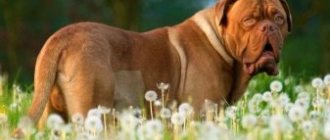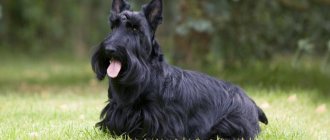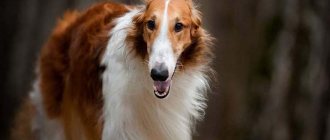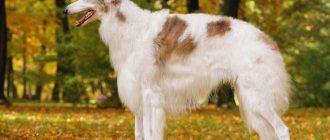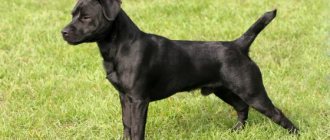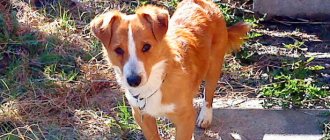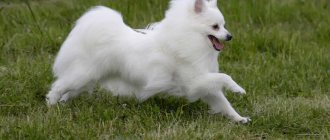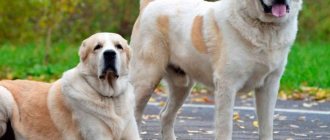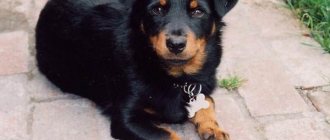Breed characteristics
| Short description | |
| Origin: | Afghanistan |
| Conditions of detention: | House or cottage with spacious surrounding area |
| Purpose: | Hunting |
| Color: | Dark, bright red, red, white, ash and sand |
| Wool length: | Lengthened on the muzzle and along the body. Short on the back |
| Adult dog size: | The height of females is 22-32 cm, males 68-75 cm, weight of males is approximately 25-35 kg, females - 61-70 kg. |
| Average life expectancy: | From 11 to 13 years |
| Walk: | At least 2 times a day |
| Physical activity needs: | From 8 months onwards, average physical activity needs (walking from 1 to 3 hours a day). Intense running and jumping possible |
| Fédération Cynologique Internationale (FIC) classification: | Group No. 10 greyhounds, section No. 1 long-haired greyhounds |
| Puppy price: | From 15 to 50 thousand rubles. |
Nutrition
When it comes to food, the Afghan Hound can be extremely capricious. For this reason, a dog may refuse food for a long time that it does not like.
The animal's menu should be varied and balanced. It is necessary that the basis of the diet be protein foods. An adult dog is fed twice a day in small portions.
Afghan hound puppies should eat 5 times a day until they are four months old. Then the pets are fed 4 times until six months. Then, up to a year, the daily nutritional norm is three meals a day.
The list of unacceptable foods for feeding an Afghan hound includes:
- pork;
- smoked meats;
- salty and spicy foods.
It is necessary to feed your dog with at least premium food. If an Afghan eats regular food, then the owner should approach the issue of creating a menu with the utmost seriousness.
Daily meat consumption should be approximately 50-60%
Eggs, fish, and cottage cheese can serve as additional sources of protein. Your pet's daily diet must include porridge and vegetables.
History of the origin of the species
The first mentions of the breed were found in Iranian drawings in the 11th century. BC. Much later in the 2nd century BC. corresponding inscriptions were applied to the walls of the dugout in Afghanistan. Today the dog is considered a symbol of this state. Most recently, the government lifted the ban on the export of greyhounds for sale outside its borders. This breed was brought to Europe by officers from England. They spotted her on the border with Afghanistan while returning from India.
The first official club appeared only in 1926 in England. Experts were able to evaluate the adaptive qualities, so the breed standard was confirmed.
History and origin
The Afghan Hound is one of the oldest breeds. Biblical scriptures state that Noah took a pair of greyhounds on board his ark. Scientists agree that the breed is hundreds of years old.
Modern purebred Afghan hounds trace their history back to the greyhounds brought to Britain by the military at the beginning of the 19th century and immediately captivating the British with their grace and aristocracy.
Already by 1920, almost all varieties of aboriginal greyhounds from Afghanistan and surrounding regions were imported to Great Britain, and in 1926 the Afghan breed was registered.
Distinctive features
The Afghan Hound is the pride of an entire nation. Previously, they took her with them on hunts, but today they make her a participant in tournaments. They are tested for compliance with the following standards:
- The skull is narrow, elongated. There is a pronounced tubercle on the back of the head. The transition line from the forehead does not have sharp boundaries.
- The head is proportional, not narrow. Characterized by the presence of bangs.
- The nose is completely black. May be brown in dogs with light coats.
- The eyes are slanted and well defined. Triangular shape.
- The ears are large and hang down to the neck. They are completely covered with fur.
- Jaw – the teeth are arranged in a scissor-like manner and form a strong grip and correct bite.
- The teeth are white and straight. Plaque is not allowed.
- The neck is long and has a muscular base.
- The limbs are strong, smooth with well-developed muscles. The elbows are set close to the body. The shoulder blades are located at a slight angle to the body.
- The body is well-developed muscles. Sloping croup. The ribs have a convex structure.
- The withers are located high.
- The paws are in a free position, the fur is thick, the pads are black and soft.
- The tail is low and slightly dewy. The end is made in the shape of a ring and does not get on your back when moving.
- The coat has a dense structure with elongation on the muzzle. Short hairs are found only on the back.
- The color is dark, bright red, red, white, ash and sand.
Description of the breed
The Afghan Hound is one of the most beautiful dogs in the world. For all its elegance and grace, this is not a decorative animal. The dog rightfully belongs to the category of hunting dogs, possessing an excellent scent, endurance and swiftness.
a brief description of
- Origin: Afghanistan
- IFF classification: group 10, section 1.
- Height: males 68.5–74 cm, females 63–69 cm.
- Weight: 20–25 kg.
- Lifespan: 12–14 years.
- Cost: 40–60 thousand rubles.
Distinctive features
- Exotic expression of the eyes.
- Head covered with long silky hair.
- Strongly protruding pelvic bones.
- Large paws and excessively angulated knee joints.
- Curling tail tip.
Advantages
- Exceptional intuition.
- Smartness.
- Loyalty and devotion to the owner.
Flaws
- Poorly trained in service commands.
- It takes a long time to socialize.
- Requires daily brushing.
- Has an independent character.
Appearance
- With its entire appearance, the dog demonstrates strength, pride and dignity.
- She displays her emotions with restraint, but there is a sense of compressed energy in her, ready to explode in a swift rush.
- The head is proudly raised, which provides maximum visibility of the area.
- The muzzle is long, with strong jaws.
- The dog simultaneously looks at you and as if right through you, this look is typical for this breed.
- Movements are smooth and springy, noble posture.
The color can be varied: you can find fawn, silver, blue, black and tan Afghans. Many representatives of the breed have a mask on their face.
The archetype of the modern Afghan Hound is the Bakhmul - the aboriginal hound. This is a muscular, high-fronted dog with a proud posture and an elastic, smooth gait. It is characterized by maneuverability, endurance, and jumping ability. She has good eyesight and instincts. Males can reach: 68-73 cm, females: 65-70 cm. The color is often fawn of all shades, white and underhaired. A characteristic feature is the long, thin and straight coat that forms the “pants”.
Character, temperament, behavioral characteristics
Afghan women are smart and learn quickly, but they may simply not want to follow commands that they don’t like, and their natural cunning, independence and stubbornness allow them to resort to various tricks.
The character of these dogs is formed in parallel with the process of socialization and this lasts for three years of life.
The dog becomes very attached to its owner, is jealous and does not tolerate separation well.
Afghan hounds do not really like children and react to them with caution, but they do not show aggression towards them and stay aloof. This is due to the fact that dogs are shy and do not like sharp sounds.
The guard instinct is developed no worse than the hunting instinct; they can attack family friends or neighbors. It takes time for a dog to “get to know” new people.
Due to the highly developed instinct of the hunter, calling to catch up and catch, cats, rodents and small animals are perceived as prey. An exception may be the pets with whom they grew up: the greyhound will treat them indifferently.
Breed standards
- The head is set high, wedge-shaped, with a well-defined occipital protuberance. The forehead is flat, not too narrow, hidden behind the intense coat.
- The muzzle is long and triangular in shape.
- The nose is long, with a straight and narrow bridge. The nose is black; in light-colored dogs, dark brown is allowed.
- Color is not limited to the standard, however puppies with white spots are rejected.
- The jaws are strong and strong. Scissor bite.
- The eyes are almond-shaped, dark in color. A golden color of the cornea is allowed. Set wide, at a slight angle.
- The ears are set low, long, triangular, hanging, covered with long and thick hair.
- The neck is long, muscular with a pronounced transition to the head.
- The body is graceful, elongated, strong. The belly is lean, the chest is dry, wide, oval.
- The front legs are long and wide, the hind legs are long, narrower than the front legs.
- The tail is whip-shaped, set low, and the hair is low. The end of the tail is bent into a ring. When moving it stays high.
Photo of an adult dog
Content Features
Bakhmul will not give up the comfort of home, but the best option for him would be to keep him in a spacious enclosure with an insulated booth or in a separate room with free access to the yard. The fur of the Bakhmul has no undercoat, but it is able to protect the dog from heat and cold and does not have a specific odor.
Bakhmuls need to be regularly taken to the fields so that they can maintain working shape. A mechanical hare cannot always replace free running. In addition, smart greyhounds do not always agree to run for a rag, or perform the task without interest. On days free from hunting, the bakhmul should be walked without a leash, away from roads, preferably in a field.
Bakhmul limits himself in food, and therefore is not prone to obesity. Eats about 0.5 kg of food per day. Traditionally in Afghanistan, dogs were fed lean lamb on the bones and wheat bread with milk. Today, many owners prefer ready-made dry food.
Care
The long hair of the Bakhmul does not require complex care. It is enough to comb it periodically, always after walks in the field. Bathe as needed, usually once every 2-3 months. Be sure to monitor the length of the claws, cleanliness of the ears, eyes and teeth.
Photos of puppies
Character
The Afghan Hound has a peculiar temperament, stubborn, complex and arrogant. Because of this, difficulties in training may arise. Most often, the owner fails to achieve discipline, so the help of a professional dog handler is required. However, those who claim that these animals are stupid, obstinate and vindictive are categorically wrong.
The character of Afghans is formed slowly, as they become socialized, and only becomes apparent when they reach full adulthood—at the age of three. A well-mannered, well-trained greyhound is the result of systematic and competent training. This is why you need to approach dog training with full responsibility.
As a result, you can get an animal that is smart, dexterous and devoted to all family members with highly developed intelligence and self-esteem.
The dog develops a friendly relationship with children, but it is not recommended to leave it alone with a small child. A strong Afghan may accidentally push the baby and thereby cause him harm.
Features of character and behavior
Opinions about the Afghan hound are controversial . The owners note the unusual character. Some also claim that she can be uncontrollable and revengeful. However, any difficult character can be dealt with with the right approach.
Experts recommend early socialization. It is produced throughout the entire period of growing up. Thanks to this, it is possible to obtain proud and fearless dogs. They can come into conflict with an animal that is significantly larger than them in terms of volume and speed of movement.
The breed is fast, with excellent memory. Without attention, the dog becomes capricious. It is not recommended to be intrusive and touch their fur. Prohibitions should be introduced from childhood. In adolescence, dogs can be hot-tempered because they want to dominate.
Advantages
For each owner, their own dog is considered unique. However, there are common advantages that characterize the entire breed:
- Affectionate.
- Tender.
- Trainable.
- Energetic.
- Hardy, with a complete absence of fear.
- They have personal dignity.
A dog can demonstrate these qualities with proper upbringing and regular communication with its owner.
Flaws
Unfortunately, there are a number of disadvantages that characterize the Afghan watchdog:
- Capricious.
- Proud.
- Tend to show aggression.
- They may suddenly become afraid.
- A person may have problems during his upbringing.
- Constant coat care is required.
- Should not be started in families with children under 7 years of age.
Puppies
The Afghan Hound, whose puppies, unlike adult dogs, have short hair, must be accustomed to hair care procedures from childhood. Otherwise, it will be difficult or impossible to convince people that this is the first need.
This breed is a slow-developing one, and even at 12 months, Afghan Hound puppies are clumsy, inexperienced, and mischievous. What is characteristic of a little Afghan?
- Selectivity in food. There is little of it due to the small size of the stomach. A puppy who doesn't like the food being served will not sit on it and may lose weight. This can result in the coat becoming dull and rough. Freshness, balance and variety of the menu are the main requirements in a puppy’s nutrition.
- Love for toys. Next to the mattress laid out for your pet, there should be toys, preferably made of solid rubber, so that the animal’s bite is formed correctly. If the dog has nothing to do while the owner is away, then damaged furniture, shoes and other property will await him.
Briefly, the rules if a little Afghan appears in the house:
- say a strict “No!”;
- ensure that fresh water is available;
- leave the night light on for the first time;
- praise for good behavior;
- make sure not to overheat or overcool;
- don’t worry, if the puppy sleeps a lot, this is normal for him;
- do not teach him to ask for food from the table;
- provide ample running space.
Care and maintenance
The Afghan Guard is a show breed . The owner must carefully care for the coat. The breed standard does not require shavings on the animal. That is why, when a hairstyle is created, the dog will no longer be able to take part in exhibitions.
- It is necessary to regularly inspect the appearance. Particular attention should be paid to the eyes. They collect contaminants, which are removed with plain water or weakly brewed tea.
- Nails are trimmed once every 30 days. The procedure is performed using a special tool. Otherwise, the animal may develop cracks.
- The dog's teeth are brushed twice a week. Special brushes and pastes are also used for this.
- You should clean your ears thoroughly every week. Special bones can help in this matter.
- It is also necessary to regularly rub your eyes with chamomile or black tea.
- The dog must have its own bed.
- Walks are carried out only with a leash. The animal needs communication with other representatives of the breed.
- For the necessary physical activity, you can give him to the section.
- It is best to avoid walking in hot weather. Otherwise, the risk of heat stroke increases.
Nutrition
The health and longevity of any animal will depend on properly selected food. The frequency of feeding is selected according to age needs:
- Up to 4 months – 5 times a day.
- From six months to a year – 4 times a day.
- Over one year old – 3 times a day.
- Over two years - 2 times a day.
The dog's diet should include:
- Lean chicken, beef, ocean fish.
- Offal.
- Low-fat fermented milk products.
- Boiled eggs.
- Porridge: oatmeal, rice, buckwheat, millet.
- Green vegetables, beets, cabbage.
- It is allowed to give a small amount of fresh herbs.
- Any premium dog food will also work.
Sausages, fatty meats, sweet pastries and legumes should be completely avoided in feeding.
The drinking regime directly depends on the method of nutrition and the time of year. For example, natural food contains a sufficient amount of liquid. That is why the dog practically does not drink it separately. It is important to always have fresh water in your dog's bowl. If you plan to take long walks, you should take at least 0.5 liters with you. On a hot day, the volume increases in direct proportion to the weather outside.
Health
With proper care, the dog will live up to 14 years. The breed is not classified as an ornamental breed, so it rarely exhibits genetic deviations from the normal range. With proper nutrition and the use of additional vitamin complexes, the dog will have good health.
However, it is very sensitive to even minor skin damage. The animal suffers from pain and cannot tolerate anesthesia. That is why owners should be more attentive to his health.
Vaccinations
The dog must be vaccinated against distemper, rabies, parvovirus enteritis and viral hepatitis.
Vaccination of puppies and adult dogs is carried out according to this scheme:
- The first procedure should be performed within 2 months. Treat for helminths within 10 days.
- The second one is in two weeks. You can start walking outside for the first time and interacting with other animals after 14 days.
- The third - in six months.
- The fourth - per year.
It is advisable to carry out repeated vaccinations to maintain immunity every year until the end of the animal’s life.
Diseases
The Afghan watchdog has a strong immune system. However, even for such a breed there is a threat from the following diseases:
- Constipation due to disruption of the gastrointestinal tract.
- Cardiomyopathy is diagnosed when there is a change in the walls of the heart muscle.
- When the pleural cavity is filled with fluid, chylothorax is determined.
- Ungroomed fur is dangerous. It provokes the development of dermatitis, eczema and other skin diseases.
- Myelopathy is a disorder of the spinal cord.
- Various pathologies in the functioning of the eyes.
Walk
The breed requires walks at least twice a day. With the proper level of activity, it is possible to prevent the development of dangerous diseases and age-related diseases. The animal can gallop or jog for a long time.
It is advisable to start training no earlier than 8 months. Otherwise, the animal may develop shoulder girdle diseases. It is advisable to walk only with a leash.
Grooming
A brush with soft bristles is used to comb the fur . In order not to cause pain to the dog, combing the hair begins from the ends. Gradually you should move to the roots. Full bathing is performed once every 10 days. For this, only special shampoos and balms are used. The hairs are carefully combed to prevent the formation of tangles.
The dog should visit the groomer regularly. Thanks to the right haircut, you will be able to maintain the correct shape of your hair for a long time.
It is recommended to carry out such care at least once a month.
Features of care
This breed of dog is not suitable for keeping in an apartment. The animal needs a lot of space and regular exercise. If they are absent, the dog may get sick.
If the pet is kept in an apartment, then it needs daily walks, which in total should last at least three hours.
During the walking period, the Afghan should be allowed to run and, if possible, be occupied with active games, for example, agility .
Important! Be sure to inspect your animal's paws for wounds and cracks after walks. If present, the affected areas are wiped and lubricated with vegetable oil.
The dog not only needs active walks, but also requires special care. This applies to the ears, eyes, claws and fur of the animal.
You should regularly examine your pet's eyes and prevent souring. From time to time they are wiped with weak tea leaves using a cotton pad.
Ears, if dirty, are also treated with a damp cotton pad.
The Afghan's claws are trimmed once every four weeks with a special nail clipper for large breeds.
Up to two times a week, the dog undergoes oral hygiene using a specialized paste and brush. It is also necessary to use toys that help clean teeth.
Afghan Hound puppies should be taught the rules of hygiene from a very early age so that they do not resist any procedures in the future.
The Afghan needs to be socialized with other large breeds when walking.
Mating
The third heat is considered optimal for mating. The process occurs over a period of 1.5 to 2 years . Males are bred up to 4 years old , bitches - up to 2 years old . The standard period is from 10 to 12 noon . The bitch must be completely ready for fertilization. The dogs are introduced in advance. It is important to take time for pre-courtship.
Afghan Hound characteristics
A breed of dog such as the Afghan Hound has its own individual character, which allows it to differ significantly from other animals.
Not every person is able to give her a good and quality lifestyle, and it is not suitable for everyone. The Afghan Shepherd requires competent education, training and even a somewhat strict attitude, but not rudeness.
A certain way of life for this breed is an already formed foundation that either suits a person or not.
Health
An important part of an animal’s life is its physical condition, which in a certain way depends on the owner, how he maintains the dog, what kind of stress he can give, how accurately he can determine a change in behavior, etc.
Despite her general good health, she has a low sensitivity to pain, which sometimes, even with minor injuries, can quickly take her out of a healthy physical state.
Genetic predisposition:
- Diseases of the musculoskeletal system, problems with the pelvis and hip joint - dysplasia. It can appear at an early age of 2 years; the genetic predisposition is inherited from the pet’s parents.
- Diseases of the organs of vision. Early blindness, cataracts, corneal detachment. Decreased vision at a young age indicates serious problems.
- Frequent diseases of the hearing aid. The ears are one of the weak points, as they have an abundance of thick hair, are in a constantly closed position, and inflammatory processes develop. If the development of the disease is not prevented in time, and preventive measures are not carried out, then hearing loss and complete deafness can occur very early.
- Problems with the intestines and digestion. A common problem, the animal is very picky about food, has a rather delicate stomach, has a fast metabolism, and in the absence of proper nutrition, intestinal volvulus can occur, which will lead to death. Stomach diseases are also common.
All diseases in dogs that can be cured with medications can be stopped quite simply, provided that they were noticed in time.
- Veterinary medicine has already reached a certain step in development, specialists have good knowledge and equipment, so you should not treat your pet with folk remedies or hope “what if it goes away on its own.”
Key points in training
Training Afghan Hounds requires patience and skill. The result will not be noticeable immediately. However, it is strictly not recommended to give up training. At the first stage, you should master simple orders. It is necessary to develop a motivation system that is interesting for the dog. Initial attempts should be made immediately after the puppy appears in the house. He can be stubborn and show character. Before the age of 12 weeks, contact with the owner is established, so sufficient communication is necessary. You can teach your puppy the following commands on your own:
- "To me"
- "Place"
- “Sit and lie down”
- “Give me your paw!”
These manipulations are considered basic, therefore they are part of almost all first training sessions. The character of the dog should be taken into account. She should not be scolded or ignored. Encouragement and communication play an important role here . The owner must demonstrate respect and love. Only in this case the desired result is achieved. Afghan hound training is best done under the direct supervision of a professional in this matter.
The process requires maximum effort only on the part of a person. Additionally, you will need to come up with a learning algorithm individually. It depends on temperament and contact with the owner.
Read about how to properly train a dog in the article: “Training a puppy: effective methods from dog handlers, learning commands at home.”
Afghan Hound breed standard characteristics
The Afghan Shepherd – belying its refined appearance, has deliberate endurance, strong bones and a good strong jaw. For the standard of Afghan hounds, the following requirements are imposed, which must be mandatory:
Muzzle and head
Strong, elongated, with the ability to gain maximum visibility of the area around itself, which will allow it to clearly and quickly respond to the slightest movement. The eyes are round, more like almond-shaped, dark in color.
Make sure to paint your nose – black or dark brown. The eyelids are colored depending on the color of the coat. Ears – long, hanging ears, located in proportion to the level of the middle part of the skull, triangle shaped, lower than those of other dogs.
Breast
A wide chest allows the cardiac system to work with particular ease; when running fast, it is required not to stop, which will allow it to pursue prey, and the heart muscle has the ability to quickly recover and work without interruption due to this width. It is of medium size and proportional to the body.
Body
Strong bones, with lean muscle mass, elongated, but looks proportional. Long front paws, seem quite thin, dense rounded pads, rough. The movements are smooth, fast with a wide scope.
Tail
Saber-shaped, long, thin, covered with thick hair, flowing beautifully down it. At rest, it is located above the level of the lower back, in a ring.
Wool
One of the main advantages is that it is straight, long, shiny, and falls like a beautiful waterfall. On the muzzle it is short and glossy. It is quite pleasant to the touch and has no waves or curls. Having such a long coat that does not interfere with her movement, she is quite easy to care for, with her own characteristics, but without any frills.
According to the characteristics and description of the breed, Afghans have a certain weight, structural features and height at the withers:
- Males no more than 73 cm, females 62-63 cm;
- Weight no more than 25 kg for males, no more than 22 for females.
The Afghan is a light dog, but very hardy, its dry structure is a definite advantage for hunting and life. Develops speeds up to 60 km/h. The colors vary, the most common being brown and white.
How to choose a puppy
- Puppies of this breed look quite simple. They behave clumsily and are covered with a thin layer of fur. They may appear to be shedding.
- It is best to adopt a puppy at the age of three months. By this time, their coat should become thicker and have a slight wave. By nature, the dog is already completely independent and does not depend in any way on its mother. Experts in this matter can already consider a number of possible breed problems. A person without proper experience is unlikely to pay attention to such nuances.
- When making your own choice, you should analyze the dog’s paws in detail. They must be perfectly even. The coat shines in the sun and looks healthy. If the choice is between two dogs, then you should buy the one that tries to play with the future owner.
- Before purchasing, you should carefully analyze the mother's documents. If a disqualifying mark is found, then it is best to refuse to purchase a puppy.
- It is also recommended to analyze the condition and position of the teeth. The dog must have the correct bite. No dirt should be allowed to accumulate in the ears. Otherwise, hearing problems may occur in the future.
The Afghan Hound is a loyal and intelligent dog breed. She adores her owner and is ready to stand up for him. This breed is long-haired. That is why you will have to pay maximum attention to care.
History of the breed
The Afghan Hound is an ancient dog (the history of the breed goes back two millennia). At the dawn of humanity, she did not look like the sleek, aristocratic beauty of today. A fast, lean dog, maximally adapted to existence in the harsh conditions of mountains and deserts - other landscapes are rare in Afghanistan. The Afghan aboriginal hound was initially distinguished by its aggressive disposition, and its coat, which is the beauty and pride of the modern breed, was short.
This breed has several names. Simplified and common among Russian speakers - Afghan. The name bakhmul is applicable to greyhounds with a fawn color; they were separated into a separate standard (any light color is acceptable). But Afghan hunters called their pets the word tazi - fast running. Due to these qualities, they were used for baiting horse hunting. The main use is hunting wild animals with dogs, and fearless Afghans not only deftly caught small rodents and even birds, but also rushed at large predators.
It is necessary to distinguish between Tazi, which is another name for the Afghan hound breed, and Tazi, the name of a very similar dog, the Turkmen or Central Asian hound. These game animals have common roots and origins, hence the amazing similarities.
This breed was prohibited from being exported beyond the borders of Afghanistan in the 19th century, but then English officers managed to export several representatives of the greyhound to England, where a hundred years ago a club for lovers of this breed was created in London. From there they spread throughout Europe. Then this dog appeared in America.
Hound hunting with Afghan hounds soon became a favorite pastime of aristocrats. Hunters from high society received aesthetic pleasure from watching the beautiful fast running of a dog during the hunt, which can reach a running speed of over 50 km/h. The maximum speed recorded for this breed is 60 km/h. Only the Greyhound has a high running speed. But fast Afghans can only run for a short time – just long enough to overtake their prey. Feature: the dog immobilizes living creatures and waits for the owner to approach.
Another purpose of the breed: autochthonous greyhounds participated in the protection of livestock and homes. At the moment, hunting with their participation is rare; they can participate in races. Almost no dog show is complete without them.
Care
All the difficulties in caring for the breed are associated with long hair. To make your pet happy with its well-groomed, silky hair, it is necessary to carry out regular procedures:
- daily combing of matted fur;
- wetting the wool after combing with water and a few drops of a special conditioner;
- if there is heavy contamination, it is better to wash the wool first and then comb it;
- you need to comb in the direction from roots to ends, and not vice versa;
- To prevent long hair from getting into the bowl when the dog is eating, use a net.
The Afghan is an active dog, so regular walks are as necessary for her as air. She loves to run, even alone, and her hunting background makes itself felt. If they come across rodents, cats, cars, then she expresses a desire to pursue them.
Afghan Hounds were bred in the cold conditions of the mountains of Afghanistan, so they do not tolerate heat well. Walking in hot weather should be reduced to a minimum.
Walks should last about 1.5-2 hours, most of this time should be exercise, such as running. Socializing your pet with other large dogs is advisable. The experience of Afghan owners shows that if dogs communicate with their relatives during walks, they are more balanced at home.
Dogs sometimes like to spend time alone, so he should have a secluded place to rest where he will not be disturbed. Greyhound loves toys very much. Don't leave him without them when you leave for work, otherwise the dog will chew furniture and clothes.
